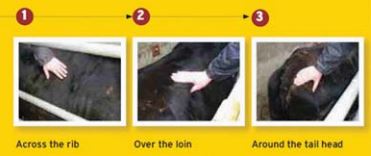



Don't Underestimate Importance of Dry Cow Feeding
Body condition as a key influence on getting beef cows cows back in calf was stressed at this year's Agriculture Food and Development Authority (Teagasc) national beef conference.Feeding extra to thin cows after they calve has very little effect on shortening the length of time it takes to get them cycling again, write Teagasc consultants.
Because of this, it is vital that cows are fed correctly during the dry period over the winter to ensure they calve down in the correct condition next spring.
Cows need to be grouped for feeding according to their body condition. Ideally, you should have three different groups:
- Cows that are in good condition that can lose some of it between now and calving
- Cows that should maintain their body condition
- Cows that need to gain condition between now and calving
How to Body Score Your Cows
How much each group is fed will depend on the quality of the forage you are feeding.
Where silage is of good quality, you may be able to restrict the amount fed to varying degrees for the first two groups of cows, which will help to save on your winter feed costs. The thin group of cows should not, however, be restricted, as they need to gain condition.
If silage quality is poor, they may need to be supplemented with 1-2kg of ration. Remember also that in-calf suckler cows on a forage diet need to be supplemented with an adequate mineral and vitamin supplement over the winter.
Be careful of supplements that may be priced at the low end as they may not supply enough of the essential minerals and vitamins that cows need.
When you are feeding 100g per day of a supplement to a cow, that costs €200 per tonne more, but supplies everything she needs, it will only cost an extra €3 per cow over a five-month winter compared to a cheaper, less effective supplement.
Your adviser can give you guidelines on what should be in an effective supplement for dry suckler cows.



